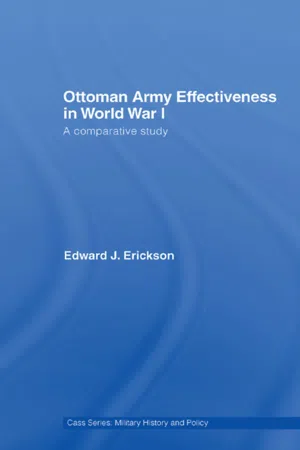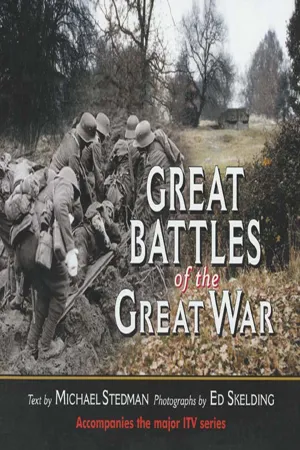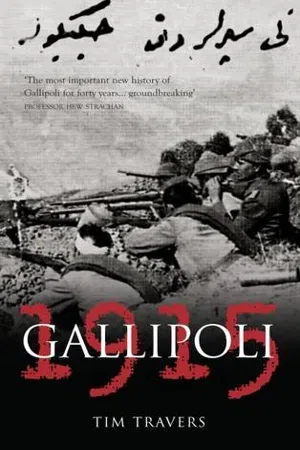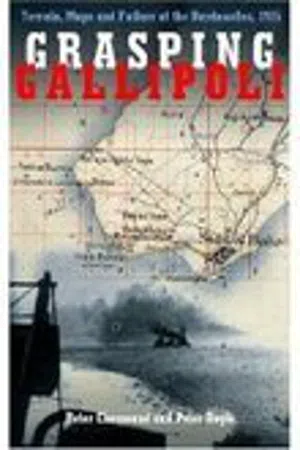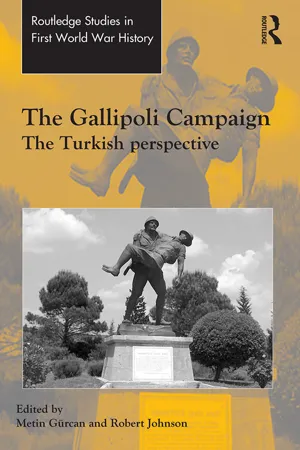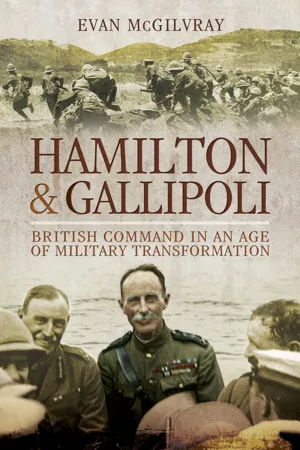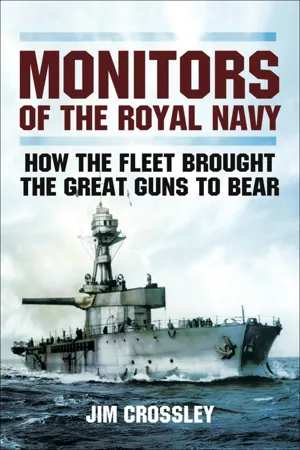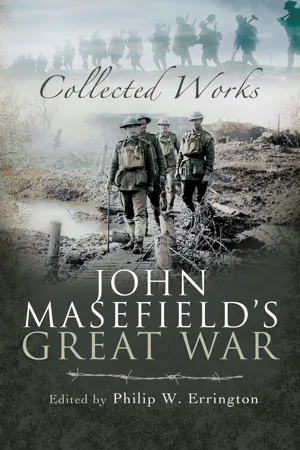History
Gallipoli Campaign
The Gallipoli Campaign was a World War I military campaign in 1915 that aimed to secure a sea route to Russia and knock the Ottoman Empire out of the war. Allied forces, primarily from Australia and New Zealand, landed on the Gallipoli Peninsula in modern-day Turkey but faced fierce resistance from Ottoman troops. The campaign ultimately ended in failure and heavy casualties on both sides.
Written by Perlego with AI-assistance
Related key terms
Related key terms
1 of 4
Related key terms
1 of 3
11 Key excerpts on "Gallipoli Campaign"
- eBook - ePub
Ottoman Army Effectiveness in World War I
A Comparative Study
- Edward J. Erickson(Author)
- 2007(Publication Date)
- Routledge(Publisher)
2 Gallipoli, 1915The English officers were brave but inexperienced, and did not seem to know how to command or lead their soldiers in battle.(Turkish officers to Capt. R.H.Willliams, USA, Gallipoli, 6 November 19151 )The Gallipoli Campaign continues to exert a seductive lure for historians and ordinary persons alike.2 Unique among World War I battles, it combined modern amphibious operations with a sweeping strategic plan on a landscape pockmarked with classical and romantic sites and memories. The name Gallipoli itself evokes controversy and the campaign is, perhaps, the greatest ‘what if of the Great War. For the Turks, Australians and New Zealanders the campaign symbolised a coming of age as these peoples entered the mainstream of the twentieth century.The campaign and its subset of battles have been well documented from the allied side over the past eighty years.3 The most commonly held notion about the Ottoman victory is that the Turks stubbornly held on long enough for a series of allied mistakes to disable the allied plan.4 At the tactical level, a 2001 history blames British command failures, friction between the army and navy, and inexperienced troops and commanders as reasons for failure.5 At the operational level, a 1995 history noted that ‘the Turks always managed to concentrate more troops at the crucial points for the simple reason that they had more troops readily available on the peninsula’.6 At the strategic level, a third history published in 2003, found that the campaign itself was ill conceived and incompetently executed.7 The older histories contain variants of these themes. Finally, every history noted includes the notion that the Turks won because of the generalship of Liman von Sanders and Mustafa Kemal and because their fighting men were incredibly tough soldiers.8 - eBook - ePub
Letters from Gallipoli
New Zealand Soldiers Write Home
- Glyn Harper(Author)
- 2013(Publication Date)
- Auckland University Press(Publisher)
INTRODUCTION THE GALLIPOLI CAMPAIGN MUDDLE , MYTH AND MEANINGIt is an extraordinary country to look across – range after range of high hills, precipice and gully, the despair of Generals, the grave and oblivion of soldiers .1THE FIGHTING THAT OCCURRED at Gallipoli for most of 1915 holds a particular fascination for Australians and New Zealanders. This is especially true in Australia where Gallipoli has been described as ‘surely the most overworked subject in Australian military history’; so much so, that Australian historian Robin Prior once suggested that historians should be awarded grants for not writing books on Gallipoli.2 Interestingly, since making this remark, Professor Prior has added a Gallipoli book to his impressive list of publications. The primary reason for this intense focus is that the campaign was the first significant military engagement on the world stage for both nations and has assumed a cultural significance out of all proportion to the military realities of the time, overshadowing other military engagements of equal or even greater importance.This peculiar fascination with Gallipoli has seen it develop unique characteristics. For a start, it is most unusual for nations to associate one of their most defining moments with a severe military defeat, one that was marked from its very beginning with poor planning, muddle and confusion. More than any other battle or campaign, the Gallipoli experience sustains several powerful and persistent myths, some of which are addressed in this introduction. Such myth-making was probably inevitable given the meaning that both Australia and New Zealand have invested in this campaign. It is part of what Australian historian Peter Stanley has called ‘the cocoon of myth and exaggeration which so often envelops the high points of a nation’s war history’.3 - eBook - ePub
- Michael Stedman(Author)
- 2010(Publication Date)
- Pen & Sword Military(Publisher)
Once Turkey became a belligerent on the side of the Central Powers, on 29 October 1914, the way was clearly open for Britain to deploy her traditional strength of naval power. In the European theatre of war, because of the very limited length of German coastline and the inaccessibility of the Baltic parts of that coastline, it had been difficult to visualise any seaborne assault on Germany being successful. But Turkey’s extensive coastline seemed far more promising and susceptible to British naval strength. Britain declared war on Turkey on 5 November. At the time few voices were raised to point out the great size of Turkish land forces, some 500,000 men with another 250,000 in reserve depots.However, within the sterile and immobile European context the chosen tactics which unfolded on the Gallipoli peninsula were, potentially, both innovative and imaginative. Those operations would evolve into a combined naval and land forces operation against the Gallipoli peninsula, a narrow strip of land above the Dardanelles whose waters run between Asia and Europe. That chasm between culture and expectation had always been an uneasy one. Now, in April 1915, it was to escalate into an extraordinary battle whose purpose, seen from the British perspective, was to sever the influence of the Turks from the German – Austrian Central Powers.This would be an outflanking manoeuvre on the grand scale.The strategic importance of the Gallipoli peninsula’s coast was clearly not lost on the German command. Any failure on Turkey’s part to dominate The Narrows would then allow the British High Seas Fleet the opportunity to attempt to force a passage through the Bosphorus2 . That severance would allow Russia access to the Mediterranean and enable, if not the opening then at least the real threat of, a third front in the land battle against the Central Powers.Because of the area’s clear and significant importance and the close links between the Turks and the Central Powers a German military advisory team had been established on Turkish soil since the early weeks of 1914. The mission had been requested by the Young Turks in 1913. That assignment, ostensibly to modernise the Ottoman Army, was ably led by General Liman von Sanders who was appointed Commander-in-Chief of the Turkish First Army on 27 August 1914. Prior to that a steady stream of German technicians, officers, instructors and war materiel had arrived during the first months of 1914 to revitalise the morale and efficiency of Turkey’s army. Sanders’ guidance had overseen the construction and development of limited defences along the Gallipoli peninsula’s coastline. He had completely reorganised the tactics and training of Turkish infantry, turning men whose units had been unpaid and untrained into a dedicated and effective force. - eBook - ePub
- Tim Travers(Author)
- 2016(Publication Date)
- The History Press(Publisher)
1THE ORIGINS OF THE MILITARY CAMPAIGN AND THE NAVAL ATTACK AT GALLIPOLI
February – March
*The Gallipoli Campaign of 1915 began with an appeal from Russia for help. However, this was followed by disorganized planning in London. In February and March, Allied naval forces attempted to knock out Turkish artillery and forts at the Dardanelles Straits, while also sweeping up Turkish mines. It proved to be impossible to achieve this, and so on 18 March the frustrated Allied fleet made a final effort to break through the Straits. This, too, failed with the loss of three battleships sunk, leaving the Turkish defences still in good condition. So by 22 March the emphasis shifted to an Allied army landing. Strangely enough, Sir Ian Hamilton’s decision to land the Army in the south of the Gallipoli peninsula rather than in the north at Bulair was a crucial factor in the British Navy’s decision to give up the purely naval attack. In general, the Allied naval failure of February and March 1915 seems to have had deeper roots than simple technical inability.T he immediate origins of the Allied campaign began with an appeal by the Grand Duke Nicholas of Russia to Britain on 2 January 1915 for a demonstration to help against the Turks, who were attacking in the Caucasus. The significant word here is ‘demonstration’; it was not a call for a large-scale attack. The next day, Kitchener and Churchill met to consider the situation, and later the same day, Kitchener wrote to Churchill saying that troops were not available, but that the only place where a demonstration might stop troops going east (presumably Russia) was the Dardanelles. According to the First Sea Lord, Sir John (‘Jacky’) Fisher, this was the document that actually started the Dardanelles operation, plus Kitchener’s advocacy of the plan in the War Council. The next day, Fisher sent Churchill a typically audacious but impractical plan for a large-scale joint army-navy operation against Turkey, involving Britain, Bulgaria, Greece, the Serbs and Russia. Fisher’s mercurial personality soon led him to support another subsidiary plan a few days later, an attack on the Turkish port of Alexandretta, a favourite target of British strategists. The same day that Fisher’s plan arrived, 3 January 1915, Churchill telegraphed to Vice-Admiral Sackville Carden, in charge of the British East Mediterranean fleet, asking his opinion on a naval operation against the Dardanelles. Probably both Kitchener’s and Fisher’s ideas were the immediate genesis of Churchill’s action. But what is clear from the ferment of plans being discussed and advocated at the time – including the plan of Lt-Col. Maurice Hankey, Secretary to the War Council, to bomb crops in Germany, and Fisher’s numerous plans for Zeebrugge, Borkum, Cuxhaven, or the Baltic generally – is that a group of intelligent and strong-minded individuals, principally Churchill, Kitchener, Fisher, Hankey and the Rt Hon. David Lloyd George, Chancellor of the Exchequer, were each putting forward their own ideas, without much coordination and without much professional advice. They were, in effect, amateur strategists and tacticians. It was likely that whoever could first put together a plan that was generally agreeable would carry the day.1 - eBook - ePub
Grasping Gallipoli
Terrain, Maps and Failure at the Dardanelles, 1915
- Peter Chasseaud, Peter Doyle(Authors)
- 2015(Publication Date)
- Spellmount(Publisher)
CHAPTER 2
Genesis of the Gallipoli Campaign
The Dardanelles, that strategic waterway connecting the Aegean Sea and Mediterranean with the Sea of Marmara and ultimately, connecting through the Bosphorus, the Black Sea, has been a point of interest to military minds for centuries. Constantinople, the modern city of Istanbul, sits astride the Bosphorus and guards the entrance to the Black Sea thereby controlling entry to the winter ports of Russia. Because of this and a myriad of other reasons, Constantinople, the seat of the Sublime Porte , the name commonly used for the Ottoman Court and the Turkish Government, has long been coveted, particularly by Greece and Russia.At the other end of the Marmara lies the Dardanelles, a narrow passageway between European and Asian Turkey, a tightly constrained waterway created by geological faulting over millennia. In European Turkey, the shores of the Dardanelles are guarded by the Gallipoli Peninsula, a narrow finger of land named after its principal settlement. Opposing this is the Asiatic Shore, the Aegean expression of the great Anatolian Peninsula, the greater part of modern Turkey, and the heart of the ailing Ottoman Empire in 1915. Fortified for centuries, the idea of squeezing a fleet of ships between the beetling brows of the shores of the Dardanelles has continually exercised the mind of the military of many nations, particularly so in the complex diplomacies of two centuries before the Gallipoli landings of 1915.It is not possible to examine the relationship between operational planning on the one hand, and geographical intelligence on the other, without taking account of the political decision-making process, and of the extent to which the military and naval authorities were admitted to this decision-making in wartime. It is therefore necessary to look at the prolonged period during which Britain’s strategic gaze, not to mention that of other European nations, was drawn to ‘The Sick Man of Europe’, and during which the consequent ‘Eastern Question’ was one of the dominant issues of political and public debate. Conflict with Russia over her approach towards India, or with Turkey over Egypt and the Suez Canal, inexorably raised the question of operations in the Dardanelles on several occasions, and on each of these occasions led to surveys, reconnaissances and intelligence-gathering initiatives which added to the data bank of available information. - eBook - ePub
Britain's 20 Worst Military Disasters
From the Roman Conquest to the Fall of Singapore
- John Withington(Author)
- 2016(Publication Date)
- The History Press(Publisher)
17
Gallipoli, 1915
Conceived as a better alternative to the murderous stalemate of the Western Front, the attack on Turkey’s Gallipoli peninsula was bedevilled by confused objectives, poor planning, and uninspired leadership. Soon it too turned into a bloody deadlock. After eleven months it was abandoned, but not before 26,000 British soldiers had been killed.Sir Maurice Hankey, secretary to the British government’s War Council, believed the first few months of the First World War had revealed that on the Western Front ‘any advance must be costly and slow. Days are required to capture a single line of trenches, the losses are very heavy, and as often as not the enemy recaptures his lost ground.’ He concluded that: ‘When viewed on a map, the total gains are almost negligible, and apparently incommensurate with the effort and loss of life.’ Perhaps, there was another way, though. Could Germany be attacked ‘most effectively … through her allies, and particularly through Turkey’? Turkey, or more properly the Ottoman Empire, was known as the ‘Sick Man of Europe’. Here was an idea to appeal to politicians shaken by the previously unimaginable carnage of the Western Front, and concerned that public opinion might soon demand a stop to it. The first lord of the Admiralty, Winston Churchill, in particular felt that there must be some better option than ‘chewing barbed wire in Flanders’ and that surely the Royal Navy could offer a way out. Despite a determined effort by Germany to build up its navy, Britannia still ruled the waves. She boasted twenty-four of the latest dreadnought battleships, outnumbering the enemy by almost two to one, and had forty older battleships against just a handful owned by the Germans. - eBook - ePub
The Gallipoli Campaign
The Turkish Perspective
- Metin Gürcan, Robert Johnson(Authors)
- 2016(Publication Date)
- Routledge(Publisher)
2 It is clear that the British naval commanders were aware of this situation, but the fact that the Ottoman Army was defeated so easily by the newly founded weak Balkan States, Greece, Bulgaria and Serbia, meant that everyone believed that the Ottoman Empire was not only ‘the sick man of Europe’ but practically a corpse waiting for post-mortem. Thus they expected little resistance from the Ottoman armed forces. After failing to get through in a purely naval operation in March 1915, the Allies decided to execute a land campaign in order to enable their fleets to pass through the Çanakkale Strait. Yet, because of the failed attempt by the French and British navies, the Allies lost the effect of surprise for their amphibious offensive, and the Ottoman Army had sufficient time for defensive preparations.The land campaign took place primarily on the Gallipoli Peninsula on the European side with some operations on the Biga Peninsula on the Asiatic side, but the decisive struggles were waged on a very narrow strip in the southern part of Gallipoli. The objective of the land campaign was not to occupy any particular place, but merely to enable the fleets to pass through the strait. They wanted to take control of Kilitbahir Plateau, located at the narrowest part of Çanakkale, destroy artillery positions both on the Asian and European sides, and finally prepare favourable conditions for the fleets to reach the Marmara Sea. To achieve their objectives the Allies preferred the shortest route. With the main landings at Helles (Seddülbahir) and Gabatepe (Kabatepe), they wanted to take control of the Kilitbahir Plateau as quickly as possible. The distance to their objective was about 20km from Helles (Seddülbahir), and eight kilometres from Gabatepe. Landing in the Seddülbahir and Gabatepe areas offered several advantages, such as naval fire support from three sides of the peninsula, shorter distances to the objective, the ability to deploy smaller forces and fewer means of transportation, and the proximity of their main logistics base on Limnos Island. On the other hand, the terrain is more suited to defence.3 - eBook - ePub
Hamilton & Gallipoli
British Command in an Age of Military Transformation
- Evan McGilvray(Author)
- 2015(Publication Date)
- Pen & Sword Military(Publisher)
5On 30 October 1914 the Turkish Navy attacked open Russian ports on the Black Sea coast. The following day The Times assessed the Turkish military, in theory and practice. It was reported that having lost both Balkan Wars, 1912 and 1913, the Turkish military no doubt had been humbled and perhaps lacked confidence, but remained a useful ‘tool’ for Germany. It was conceded that the Turk was a ‘good soldier’ and was quite well armed, mainly with German equipment. It was thought that the German commander in Turkey, Generalleutenant Otto Liman von Sanders and his Staff had ordered the attacks on the Crimean and Odessa areas on the Russian Black Sea coastline in order to try to divert Russian troops to those areas. It was also considered that perhaps the revitalized Turkish might defeat the Russian Black Sea Fleet before landing an expeditionary force in the Odessa region.6Von Sanders, in his account of his time in Turkey, made two observations connected with the comments made by The Times. The first was the pitiful state of the Turkish Army when he first arrived in Turkey during 1913; the second was the need to reform that Army from top to bottom. Von Sanders not only had to ensure that the Turkish Army was re-equipped with modern arms, paid on a regular basis rather than the ad hoc method preferred beforehand where Turkish troops might go unpaid for months, if not years, and provided with proper uniforms; he also had to attempt to remove the Turkish Officer Corps from domestic politics. Elements of the Turkish Army had been involved in the 1908 Young Turks’ revolt which saw the restoration of the 1876 Constitution and the beginning of the end of the Turkish Empire. In short, in 1913 the Turkish Army was a shambles and it is to Von Sanders’ credit that he managed to modernize it so quickly and so effectively by 1915.7 - eBook - ePub
Loyal to Empire
The Life of General Sir Charles Monro, 1860-1929
- Patrick Crowley(Author)
- 2016(Publication Date)
- The History Press(Publisher)
By the time Monro arrived, the Allied troops – British, French, Australians and New Zealanders (Anzacs) – had been on the ground at Gallipoli for over six months with little to show for it. The over-ambitious campaign had been instigated by the Russian Tsar’s request in January 1915 for an Allied demonstration to relieve pressure on the Russian front, but the landings had become more than a demonstration. In an attempt to help knock Turkey out of the war, threaten the German flank and support Russia’s war efforts there had been unsuccessful Allied naval bombardments between February and March, then landings at Kum Kale by the French and Anzac Bay and Cape Helles by the British on 25 April. Unfortunately, these assaults achieved no surprise and, as in Mesopotamia, the Turkish capability and reaction were underestimated.After various attacks and counter-attacks by both sides, the Allies launched a second wave of landings in order to break the deadlock, by outflanking the Turkish lines at Suvla Bay in August, simultaneous with further assaults. However, hopes following initial success were short-lived. By then, seven British divisions had been committed to the campaign – 410,000 troops from the British Empire were involved, sustaining just under 200,000 casualties; the French lost nearly 50,000 killed and wounded out of 79,000; and the Turks had around 195,000 casualties, of which 87,000 were killed.4Gallipoli. (Birdwood)Sixty-two-year-old General Sir Ian Hamilton had been the C-in-C since March 1915, supported by the brave and confident naval commander, Admiral John de Robeck. Hamilton was a highly respected and extremely experienced infantry officer who was very charismatic and popular with both officers and men, despite some disloyalty within his Gallipoli headquarters, making Monro’s position as his successor even more difficult, even though Hamilton had failed to break the deadlock on the peninsula. Initially, Hamilton had had only forty days to prepare and improvise the Gallipoli landings with one, untrained, regular division – the 29th Division. Without the vital element of surprise, the Allies had failed to reach 3 miles inland because of excellent Turkish leadership and the combination of enemy wire, machine guns and well-prepared dug-in positions. - eBook - ePub
Monitors of the Royal Navy
How the Fleet Brought the Big Guns to Bear
- Jim Crossley(Author)
- 2013(Publication Date)
- Pen & Sword(Publisher)
Chapter 4
The Gallipoli Campaign
W hile the first two monitors were active on the coast of Africa events of far greater importance were taking place in the Dardanelles. It was to prove one of the most disastrous actions ever undertaken by British arms. After Troubridge had been sent home in disgrace for letting Goeben escape, Admiral, Sir Sackville Carden, was placed in command of the force which was to find her, if she dared to emerge from her Turkish lair, and sink her and her consort. His task was not an easy one (see map 3).The Narrows, the passage leading from the Aegean to the Sea of Marmora was protected by powerful forts on Cape Helles and Kum Kale and by further batteries of heavy guns at Kephez and Chanak points. Even more dangerous than these was a dense minefield consisting of almost 400 moored mines in the channel which was less than 1 mile wide.A quick look at chart 3 will show the nature of the task which the navy faced. The Straits are dominated by hilly, broken country and are only about 5 miles wide at their widest point. Ships in the Straits are liable to shelling from the forts at the entrance and from others established at strategic points along the shoreline. The forts themselves were venerable structures, but around them had been built, with German advice and help, modern well designed earthworks concealing heavy guns which could survive anything short of a direct hit on the gun itself. In the hillsides looking down on the Straits were concealed mobile batteries of field guns and howitzers. These were not big enough to damage heavily armoured ships much, but they could be fatal to unarmoured vessels such as trawlers or destroyers. There were also powerful mobile searchlights to spot for the guns at night. Through the Straits runs a current of anything from 2 to 4 knots, constantly running out into the Mediterranean. This current runs strongly in the centre, but is weak or nonexistent near the shores, especially the southern (Asiatic) shore. There could scarcely be a more suitable stretch of water for defensive mining. - eBook - ePub
John Masefield's Great War
Collected Works
- Philip W. Errington(Author)
- 2008(Publication Date)
- Pen & Sword Military(Publisher)
Gallipoli
DEDICATED WITH THE DEEPEST ADMIRATION AND RESPECT TO GENERAL SIR IAN HAMILTON, G.C.B., D.S.O., AND THE OFFICERS AND MEN UNDER HIS COMMAND MARCH TO OCTOBER, 1915Passage contains an image
I
Oliver said: “I have seen the Saracens: the valley and the mountains are covered with them; and the lowlands and all the plains; great are the hosts of that strange people; we have here a very little company.”Roland answered: “My heart is the bigger for that. Please God and His holiest angels, France shall never lose her name through me.” – The Song of Roland .A little while ago, during a short visit to America, I was often questioned about the Dardanelles Campaign. People asked me why that attempt had been made, why it had been made in that particular manner, why other courses had not been taken, why this had been done and that either neglected or forgotten, and whether a little more persistence, here or there, would not have given us the victory.These questions were often followed by criticism of various kinds, some of it plainly suggested by our enemies, some of it shrewd, and some the honest opinion of men and women happily ignorant of modern war. I answered questions and criticism as best I could, but in the next town they were repeated to me, and in the town beyond reiterated, until I wished that I had a printed leaflet, giving my views of the matter, to distribute among my questioners.Later, when there was leisure, I began to consider the Dardanelles Campaign, not as a tragedy, nor as a mistake, but as a great human effort, which came, more than once, very near to triumph, achieved the impossible many times, and failed, in the end, as many great deeds of arms have failed, from something which had nothing to do with arms nor with the men who bore them. That the effort failed is not against it; much that is most splendid in military history failed, many great things and noble men have failed. To myself, this failure is the second grand event of the war; the first was Belgium’s answer to the German ultimatum.
Index pages curate the most relevant extracts from our library of academic textbooks. They’ve been created using an in-house natural language model (NLM), each adding context and meaning to key research topics.
Explore more topic indexes
Explore more topic indexes
1 of 6
Explore more topic indexes
1 of 4
